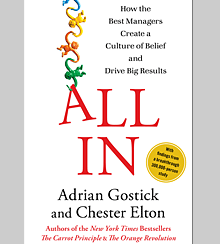Engagement Isn’t Enough
Ann Rhoades, author of Built on Values: Creating an Enviable Culture That Outperforms the Competition, introduces a lesson in attaining the full potential of employees from All In: How the Best Managers Create a Culture of Belief and Drive Big Results, by Adrian Gostick and Chester Elton.
As leaders, we often miss critical indicators that can improve the likelihood of organizational and personal success. Consider the ubiquitous employee satisfaction survey, which is usually administered once a year and, as long as the scores are respectable, crossed off the corporate must-do list. Typically, these surveys measure employee engagement levels. But as Adrian Gostick and Chester Elton explain in the excerpt below, that’s not enough. They rightly contend that employee energy and enablement are as essential to high levels of performance as engagement.
As I think back on projects that I have been associated with, it is clear that every success and failure was due not only to the level of engagement among team members but also to their energy level and the degree to which they felt enabled (or empowered) to achieve their goals. At a time when leaders everywhere are spending an inordinate amount of time identifying “A” players and getting them on the bus, it is also clear that the three Es — engagement, energy, and enablement — are the key to realizing the full potential of employees.
— Ann Rhoades
An excerpt from Chapter 3 of All In: How the Best Managers Create a Culture of Belief and Drive Big Results
On a thundery morning in Fort Lauderdale, only a few miles from where U2 played a few nights before, a crowded indoor atrium begins to take on the feel of a rock concert. Businesspeople are hanging over six floors of balconies looking down at a collection of dancers on the main floor. Then, at the urging of the lead performer, just about everyone in the building suddenly starts moving to the pulsing strains of a recording by Lady Gaga, throwing their fists in the air and shouting, “Just dance!”
When the music ends the crowd roars. The lead dancer, a middle-aged woman in a business suit, waves up at the gathering. Hundreds of people are laughing and cheering another performance by Doria Camaraza and her leadership team.
Doria who?
This mild-mannered, bespectacled woman is the senior vice president and general manager of this American Express World Service Center, located in two nondescript buildings in an industrial park in southern Florida. This is a 3,000-person call center, and the work is not easy. Customers call when they need help with a lost card or want to make an address change. Others want to dispute charges or can’t find their bill. And some are upset; perhaps they don’t qualify for a credit increase. Yet despite the often demanding atmosphere, Camaraza and her fellow senior managers have found a way to get just about all of these people to believe in what they are trying to accomplish. In fact, we might argue that she and her team are the best bunch of leaders of believers you’ve never heard of — bad dancing and all.
Here’s some proof: Around the United States, employee turnover in call centers averages about 50 percent annually. That means if you answer phones for a living, about half your coworkers will leave before another year passes. Not here. Turnover is Fort Lauderdale is in the single digits annually. Let us pause for a moment to let that sink in: Turnover is less than one-fifth the national average.
But there’s more: Productivity measures are tops in the call center industry.
Six years ago, when Camaraza took over, the call center was good. Today it’s great — helping American Express earn an unprecedented five consecutive years of J.D. Power & Associates awards for highest customer satisfaction among credit card companies. Very impressive.
But boogying in front of your employees? This is, after all, American Express — one of the world’s most prestigious business brands, and you might argue one of the most serious. Not here, says Camaraza. She calls this American Express facility a “community of caring,” and the leadership team dances every month in the atrium to get attention before the real business of this meeting, called “Tribute” — spotlighting employees who’ve gone above and beyond and those who are celebrating long-tenure service awards. As soon as the music ends, Camaraza retires to what she calls her “Oprah chairs,” two beige loungers, where she interviews a series of employees who are being spotlighted publicly for living the American Express values.
She begins with an employee from platinum-card member services who helped a stranded customer find a hotel room — despite the fact that the customer had left home without his card. “Sam spent an hour and a half on the phone until he found a hotel that would let this card member check in without his card,” she explains. “That’s living our Blue Box value of customer commitment. Sam has made a real difference in that customer’s life.” The large crowd heartily applauds the fellow’s accountability as Camaraza presents him with an award from RewardBlue — American Express’ recognition system where any employee can recognize any other employee in forty-five countries.
After welcoming another eight people to the spotlight in the Oprah chairs, and getting misty-eyed on a few occasions as she describes someone’s dedication, Camaraza steps aside and on cue a randomly selected employee from each of the facility’s large business units runs out. The blaring music returns and the five play a game of Minute to Win It, blowing up balloons and then using the captured air to try to push fifteen cups off their respective tables. The crowd begins howling in encouragement for their floors’ representatives and laughing hysterically at some of the attempts. When a slight, spunky woman from the credit group wins, employees from the fourth floor go bananas in celebration.
“Loosening up like this was especially important when we were going through the financial crisis,” Camaraza says. “Our people were working so hard. Every call that came in seemed to be challenging: Someone had lost their job and wasn’t making their payments. We had to help folks relieve the stress of a very tough environment.”
But surely some people don’t approve of such shenanigans. True, though such cranky attitudes don’t last long in Fort Lauderdale. “I don’t want to surround myself with people who are dragging themselves to work. We don’t need any grumpy poo-poo heads,” Camaraza said. “That’s a technical term,” she added with a chuckle, and we couldn’t help but laugh with her.
All this cheerfulness and productivity in today’s financial services industry is rare and is derived in part from leadership’s unique efforts to affect employees physical and emotional well-being — something that has paid off for them handsomely. For instance, Camaraza walked us through their brand-new Healthy Living Center, a workout facility with fitness classes and weights. Trainers are on staff, as is a nurse. And then she gave us a tour of the Kids Zone, a backup child-care facility. As we entered, “Who Let the Dogs Out?” was blaring from a television as a dozen excited eight-year-olds bounced in front of a video dance game as part of an exercise break.
CEO Ken Chenault and executive vice president of world service Jim Bush gave Camaraza the go-ahead to pilot the facility in Fort Lauderdale. “We have about ninety births here every year and eleven hundred dependent children under the age of twelve,” Camaraza explained. “It was a significant multimillion-dollar investment that paid back in about fifteen months. It’s a huge driver in reducing absenteeism, and we can look at the attrition of people who are registered for child care and the rest of the employee population and there is no comparison.”
Employees are eligible for up to twenty days of backup child care in the facility and three weeks of summer camp for their kids. And employees’ newborns can spend up to eight weeks in the Kids Zone. “A woman who has no children said to me today that it makes [her] really proud to work for this company. We get a ripple effect that is really powerful,” Camaraza said.
Reflecting on the positive culture at the facility, Lisa Telfer, director of business planning, told us, “You might ask why would anyone want to settle down for sixteen years in one place, but when you talk with people here you get it. You are treated well, there’s an amazing level of care and concern. And when employees are happy, that translates to customers.” Charles Johnson, the center’s HR relationship leader, said, “This is not a utopia. But if you have to work, it doesn’t get much better than this.”
In the six years this leadership team has run this facility, it has certainly been a wildly productive environment but also a hopeful and happy place. And while each of the leaders admits they are not perfect as managers, these executives have about three thousand followers who love working here — three thousand people who truly believe in the mission and the values they’re asked to follow through on.
If all this esprit de corps seems a bit overwhelming to achieve in your workplace — in your lifetime — realize that you wouldn’t be the first manager we’ve worked with to push back about undertaking a culture shift with this level of dedication. It wouldn’t work here, you might think. That’s okay. Not every manager has to go to these lengths to inject life into their culture. But there are lessons for us all to learn in Fort Lauderdale. For instance, Doria Camaraza has come to understand that being a manager doesn’t mean knowing products and services, it means knowing your people. “I don’t have much business being in this role. I don’t have the right technical background. But the role of a manager isn’t about being technically proficient. It’s about people.”
Another lesson? The culture starts at the top, said Telfer. “Everyone has a Doria story; there are three thousand stories. People don’t know how she remembers so much about them, but she literally works at making people feel welcomed and wonderful. Despite her insane body of responsibilities, she’s in touch with her people. Not to mention she goes to Zumba and cardio kickboxing classes with employees here on the campus. Who does that?”
This culture is very strong, very positive, and most important, is leading to very real results for a very large and complex organization. And Camaraza and her leadership team have kept up this kind of productivity and energy through the worst financial meltdown in our lifetime. How do they engender that kind of loyalty and commitment? This American Express call center is a case study in developing a culture of belief, with managers who are benefiting from E + E + E in action. They have achieved world-class levels of efficiency, profitability, and customer satisfaction because their employees are:
Engaged. They understand how their work benefits the larger organization and have a clear understanding of how they are responsible and accountable for real results. And they can see the value of their contributions to the company’s larger mission.
Enabled. The company supports employees with the right tools and training, and leaders spend 75 percent of their time coaching and walking the floor to ensure that workers can navigate the demands of their jobs.
Energized. Leaders at this facility maintain feelings of well-being and high levels of energy through daily productivity contests, helping employees balance work and home life, and recognizing individual contributions. In fact, at American Express, nearly 20,000 times a month employees are praised for effort or rewarded for results via the RewardBlue system.
— Adrian Gostick and Chester Elton
Copyright © 2012 by Gostick & Elton LLC. Reprinted with permission by Free Press, a division of Simon & Schuster Inc.



